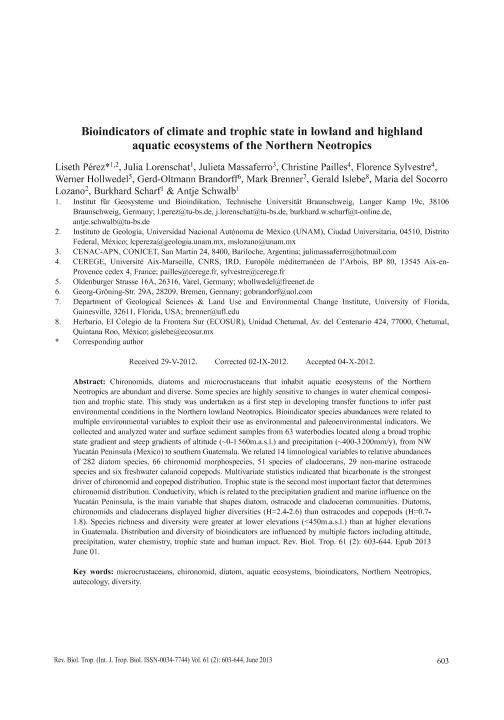Mostrar el registro sencillo del ítem
dc.contributor.author
Pérez, Liseth
dc.contributor.author
Lorenschat, Julia
dc.contributor.author
Massaferro, Julieta

dc.contributor.author
Pailles, Christine
dc.contributor.author
Sylvestre, Florence
dc.contributor.author
Hollwedel, Werner
dc.contributor.author
Brandorff, Gerd Oltmann
dc.contributor.author
Brenner, Mark
dc.contributor.author
Islebe, Gerald
dc.contributor.author
Lozano, Maria del Socorro
dc.contributor.author
Scharf, Burkhard
dc.contributor.author
Schwalb, Antje
dc.date.available
2017-07-04T20:56:38Z
dc.date.issued
2013-06
dc.identifier.citation
Pérez, Liseth; Lorenschat, Julia; Massaferro, Julieta; Pailles, Christine; Sylvestre, Florence; et al.; Bioindicators of climate and trophic state in lowland and highland aquatic ecosystems of the Northern Neotropics; Revista de Biologia Tropical; Revista de Biología Tropical; 61; 2; 6-2013; 603-644
dc.identifier.issn
0034-7744
dc.identifier.uri
http://hdl.handle.net/11336/19539
dc.description.abstract
Chironomids, diatoms and microcrustaceans that inhabit aquatic ecosystems of the Northern Neotropics are abundant and diverse. Some species are highly sensitive to changes in water chemical composition and trophic state. This study was undertaken as a first step in developing transfer functions to infer past environmental conditions in the Northern lowland Neotropics. Bioindicator species abundances were related to multiple environmental variables to exploit their use as environmental and paleoenvironmental indicators. We collected and analyzed water and surface sediment samples from 63 waterbodies located along a broad trophic state gradient and steep gradients of altitude (~0-1 560m.a.s.l.) and precipitation (~400-3 200mm/y), from NW Yucatán Peninsula (Mexico) to southern Guatemala. We related 14 limnological variables to relative abundances of 282 diatom species, 66 chironomid morphospecies, 51 species of cladocerans, 29 non-marine ostracode species and six freshwater calanoid copepods. Multivariate statistics indicated that bicarbonate is the strongest driver of chironomid and copepod distribution. Trophic state is the second most important factor that determines chironomid distribution. Conductivity, which is related to the precipitation gradient and marine influence on the Yucatán Peninsula, is the main variable that shapes diatom, ostracode and cladoceran communities. Diatoms, chironomids and cladocerans displayed higher diversities (H=2.4-2.6) than ostracodes and copepods (H=0.7- 1.8). Species richness and diversity were greater at lower elevations (<450m.a.s.l.) than at higher elevations in Guatemala. Distribution and diversity of bioindicators are influenced by multiple factors including altitude, precipitation, water chemistry, trophic state and human impact.
dc.format
application/pdf
dc.language.iso
eng
dc.publisher
Revista de Biologia Tropical

dc.rights
info:eu-repo/semantics/openAccess
dc.rights.uri
https://creativecommons.org/licenses/by-nc-sa/2.5/ar/
dc.subject
Microcrustacea
dc.subject
Chironomids
dc.subject
Diatoms
dc.subject
Aquatic Sytstems Yucatan
dc.subject.classification
Otras Ciencias de la Tierra y relacionadas con el Medio Ambiente

dc.subject.classification
Ciencias de la Tierra y relacionadas con el Medio Ambiente

dc.subject.classification
CIENCIAS NATURALES Y EXACTAS

dc.title
Bioindicators of climate and trophic state in lowland and highland aquatic ecosystems of the Northern Neotropics
dc.type
info:eu-repo/semantics/article
dc.type
info:ar-repo/semantics/artículo
dc.type
info:eu-repo/semantics/publishedVersion
dc.date.updated
2015-07-30T20:35:23Z
dc.journal.volume
61
dc.journal.number
2
dc.journal.pagination
603-644
dc.journal.pais
Costa Rica

dc.journal.ciudad
Turrialba
dc.description.fil
Fil: Pérez, Liseth. Technische Universität Braunschweig, Institut für Geosysteme und Bioindikation; Alemania. Universidad Nacional Autónoma de México, Instituto de Geología; México
dc.description.fil
Fil: Lorenschat, Julia. Technische Universität Braunschweig, Institut für Geosysteme und Bioindikation; Alemania
dc.description.fil
Fil: Massaferro, Julieta. Administración de Parques Nacionales. Delegación Regional Patagonia; Argentina. Consejo Nacional de Investigaciones Científicas y Técnicas; Argentina
dc.description.fil
Fil: Pailles, Christine. Université Aix Marseille; Francia
dc.description.fil
Fil: Sylvestre, Florence. Université Aix Marseille; Francia
dc.description.fil
Fil: Hollwedel, Werner. Oldenburger Strasse; Alemania
dc.description.fil
Fil: Brandorff, Gerd Oltmann. Georg Gröning; Alemania
dc.description.fil
Fil: Brenner, Mark. University of Florida; Estados Unidos
dc.description.fil
Fil: Islebe, Gerald. El Colegio de la Frontera Sur; México
dc.description.fil
Fil: Lozano, Maria del Socorro. Universidad Nacional Autónoma de México, Instituto de Geología; México
dc.description.fil
Fil: Scharf, Burkhard. Technische Universität Braunschweig, Institut für Geosysteme und Bioindikation; Alemania
dc.description.fil
Fil: Schwalb, Antje. Technische Universität Braunschweig, Institut für Geosysteme und Bioindikation; Alemania
dc.journal.title
Revista de Biología Tropical

dc.relation.alternativeid
info:eu-repo/semantics/altIdentifier/url/http://www.scielo.sa.cr/scielo.php?pid=S0034-77442013000300012&script=sci_arttext&tlng=pt
dc.relation.alternativeid
info:eu-repo/semantics/altIdentifier/doi/http://dx.doi.org/10.15517/rbt.v61i2.11164
dc.relation.alternativeid
info:eu-repo/semantics/altIdentifier/url/https://revistas.ucr.ac.cr/index.php/rbt/article/view/11164
Archivos asociados
